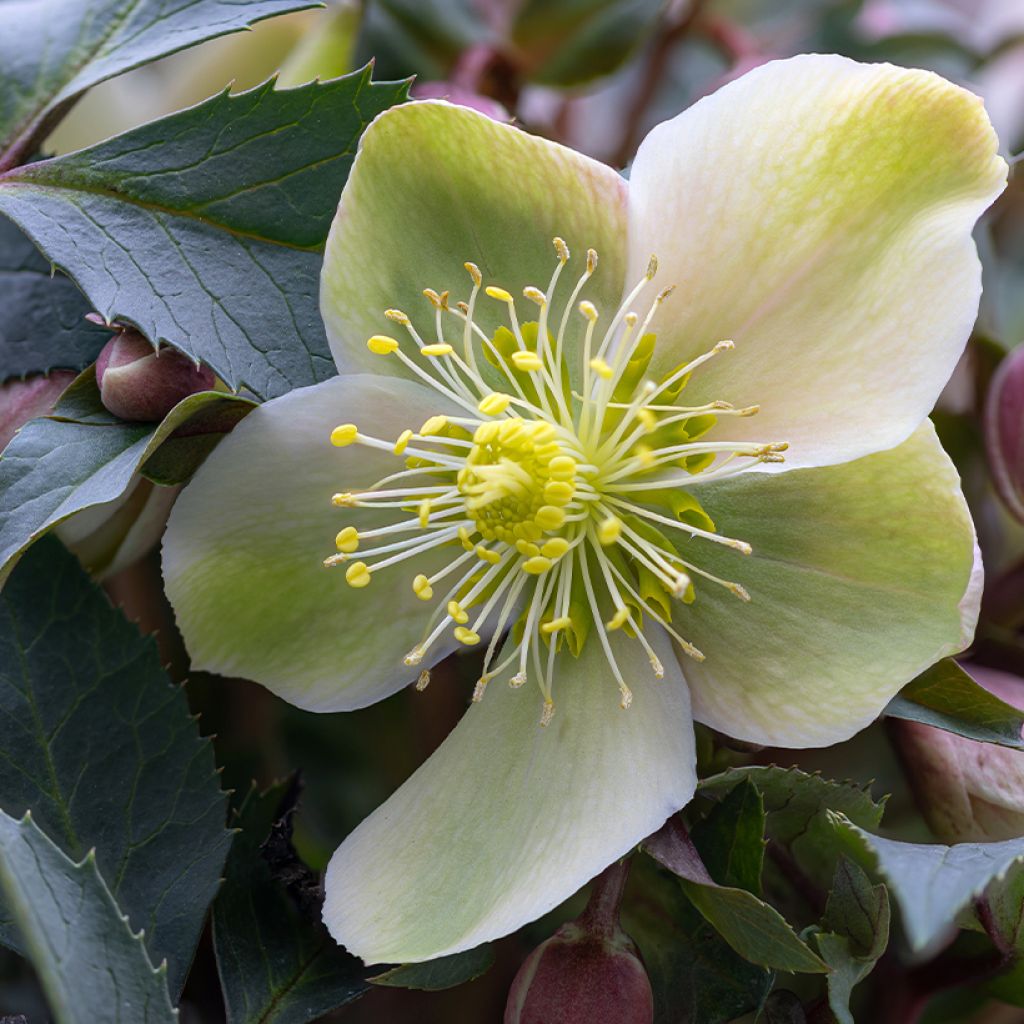

Helleborus niger - Christmas Rose


Helleborus niger - Christmas Rose


Helleborus niger - Christmas Rose


Helleborus niger - Christmas Rose


Helleborus niger - Christmas Rose


Helleborus niger - Christmas Rose


Helleborus niger - Christmas Rose


Helleborus niger - Christmas Rose


Helleborus niger - Christmas Rose


Helleborus niger - Christmas Rose


Helleborus niger - Christmas Rose
Helleborus niger - Christmas Rose
Helleborus niger
Christmas Rose, Winter Rose, Black Hellebore
Very beautiful plant, can't wait for the flowering!!
fred, 19/10/2025
Special offer!
Receive a €20 voucher for any order over €90 (excluding delivery costs, credit notes, and plastic-free options)!
1- Add your favorite plants to your cart.
2- Once you have reached €90, confirm your order (you can even choose the delivery date!).
3- As soon as your order is shipped, you will receive an email containing your voucher code, valid for 3 months (90 days).
Your voucher is unique and can only be used once, for any order with a minimum value of €20, excluding delivery costs.
Can be combined with other current offers, non-divisible and non-refundable.
Home or relay delivery (depending on size and destination)
Schedule delivery date,
and select date in basket
This plant carries a 12 months recovery warranty
More information
We guarantee the quality of our plants for a full growing cycle, and will replace at our expense any plant that fails to recover under normal climatic and planting conditions.

Would this plant suit my garden?
Set up your Plantfit profile →
Description
Helleborus niger, or Black Hellebore, is the true Christmas Rose, one of the most charming species, capable of piercing the snow with its pure white flowers when they bloom. This hellebore is a remarkably perennial plant that thrives in limestone soil, forming a clump of large, flexible leaves, from which simple white cup-shaped flowers emerge for several weeks, turning green to pink-purple at the end of flowering. Plant it in partial shade, in well-cultivated, fertile soil, and leave it undisturbed: it establishes itself slowly, but grows thicker year after year, producing more and more flowers that bring great joy when discovered on a beautiful winter morning.
Native to Western and Central Europe, from Germany to Slovenia, passing through Austria, Switzerland, and Italy, the Helleborus niger is a perennial plant of the Ranunculaceae family that readily hybridizes with other species such as Helleborus orientalis or H.argutifolius, resulting in hybrids that are delightful and easy to cultivate from random seeds. Black Hellebore is a very robust and long-lived plant, highly resistant to cold, adapting to most soils and tolerating summer drought quite well, although it prefers some moisture. In the wild, it can be found in the forests covering the slopes of the Central and Eastern Alps, between 300 and 1800m (984 and 5905ft) in altitude, exclusively on limestone terrain.
The plant forms a clump of basal leaves, reaching 30cm (12in) high and 50cm (20in) wide. It consists of bright green leaves, divided into 5 to 7 lanceolate, toothed, fairly wide leaflets which live for about 8 months before disappearing, while the new ones are already emerging from the ground.
Between December and March, brownish stems appear, bearing 1 to 3 single flowers measuring 4.5 to 8cm (2 to 3in) in diameter, cup-shaped and slightly drooping. Their colour varies from pure white to pinkish on the reverse, depending on their age, the centre occupied by yellow stamens. Hellebore is a plant that does not like to be moved once established, with young plants sometimes taking 2 years to flower. The abundant seeds are sown by ants in April-May and easily germinate after the passage of winter cold.
Use hellebores as elements of an ancient tapestry, mixing them with woodland plants in brighter colours. Black Hellebore has only one requirement: deep, fertile limestone soil, even clayey and quite dry in summer. It can be planted in groups near the entrance of the house, in a shaded location, to fully enjoy its bright and early flowering. It is an excellent plant for illuminating a shady area, for example, on the edge of a grove or woodland, with Euphorbia amygdaloides, Geranium macrorrhizum, Glechoma hederacea, Algerian Iris, or periwinkles, for instance.
Report an error about the product description
Helleborus niger - Christmas Rose in pictures




Flowering
Foliage
Plant habit
Botanical data
Helleborus
niger
Ranunculaceae
Christmas Rose, Winter Rose, Black Hellebore
Central Europe
Other Hellebore A to Z
View all →Planting and care
The Christmas Rose grows in any deep, well-drained, and loose, chalky soil, in partial or light shade, sheltered from cold and prevailing winds. It is perfectly hardy and its flowering is not affected by snow. This perennial should be planted in early autumn or spring, outside of freezing periods. It thrives in deeply cultivated soil mixed with coarse sand. The use of compost tends to acidify the soil, not desirable for this species. Water well after planting and then add a layer of mulch 2 to 5 cm (1 to 2in) thick. Regularly remove faded leaves to improve flowering. Ensure a planting distance of 40 to 50cm (16 to 20in) between each plant to promote their growth. Black Hellebore does not tolerate prolonged drought or stagnant water, which can cause its roots to rot.
It can be propagated by sowing fresh seeds in April-May. The abundant seeds will only germinate after experiencing the cold of winter.
Planting period
Intended location
Care
-
, onOrder confirmed
Reply from on Promesse de fleurs
Similar products
Haven't found what you were looking for?
Hardiness is the lowest winter temperature a plant can endure without suffering serious damage or even dying. However, hardiness is affected by location (a sheltered area, such as a patio), protection (winter cover) and soil type (hardiness is improved by well-drained soil).

Photo Sharing Terms & Conditions
In order to encourage gardeners to interact and share their experiences, Promesse de fleurs offers various media enabling content to be uploaded onto its Site - in particular via the ‘Photo sharing’ module.
The User agrees to refrain from:
- Posting any content that is illegal, prejudicial, insulting, racist, inciteful to hatred, revisionist, contrary to public decency, that infringes on privacy or on the privacy rights of third parties, in particular the publicity rights of persons and goods, intellectual property rights, or the right to privacy.
- Submitting content on behalf of a third party;
- Impersonate the identity of a third party and/or publish any personal information about a third party;
In general, the User undertakes to refrain from any unethical behaviour.
All Content (in particular text, comments, files, images, photos, videos, creative works, etc.), which may be subject to property or intellectual property rights, image or other private rights, shall remain the property of the User, subject to the limited rights granted by the terms of the licence granted by Promesse de fleurs as stated below. Users are at liberty to publish or not to publish such Content on the Site, notably via the ‘Photo Sharing’ facility, and accept that this Content shall be made public and freely accessible, notably on the Internet.
Users further acknowledge, undertake to have ,and guarantee that they hold all necessary rights and permissions to publish such material on the Site, in particular with regard to the legislation in force pertaining to any privacy, property, intellectual property, image, or contractual rights, or rights of any other nature. By publishing such Content on the Site, Users acknowledge accepting full liability as publishers of the Content within the meaning of the law, and grant Promesse de fleurs, free of charge, an inclusive, worldwide licence for the said Content for the entire duration of its publication, including all reproduction, representation, up/downloading, displaying, performing, transmission, and storage rights.
Users also grant permission for their name to be linked to the Content and accept that this link may not always be made available.
By engaging in posting material, Users consent to their Content becoming automatically accessible on the Internet, in particular on other sites and/or blogs and/or web pages of the Promesse de fleurs site, including in particular social pages and the Promesse de fleurs catalogue.
Users may secure the removal of entrusted content free of charge by issuing a simple request via our contact form.
The flowering period indicated on our website applies to countries and regions located in USDA zone 8 (France, the United Kingdom, Ireland, the Netherlands, etc.)
It will vary according to where you live:
- In zones 9 to 10 (Italy, Spain, Greece, etc.), flowering will occur about 2 to 4 weeks earlier.
- In zones 6 to 7 (Germany, Poland, Slovenia, and lower mountainous regions), flowering will be delayed by 2 to 3 weeks.
- In zone 5 (Central Europe, Scandinavia), blooming will be delayed by 3 to 5 weeks.
In temperate climates, pruning of spring-flowering shrubs (forsythia, spireas, etc.) should be done just after flowering.
Pruning of summer-flowering shrubs (Indian Lilac, Perovskia, etc.) can be done in winter or spring.
In cold regions as well as with frost-sensitive plants, avoid pruning too early when severe frosts may still occur.
The planting period indicated on our website applies to countries and regions located in USDA zone 8 (France, United Kingdom, Ireland, Netherlands).
It will vary according to where you live:
- In Mediterranean zones (Marseille, Madrid, Milan, etc.), autumn and winter are the best planting periods.
- In continental zones (Strasbourg, Munich, Vienna, etc.), delay planting by 2 to 3 weeks in spring and bring it forward by 2 to 4 weeks in autumn.
- In mountainous regions (the Alps, Pyrenees, Carpathians, etc.), it is best to plant in late spring (May-June) or late summer (August-September).
The harvesting period indicated on our website applies to countries and regions in USDA zone 8 (France, England, Ireland, the Netherlands).
In colder areas (Scandinavia, Poland, Austria...) fruit and vegetable harvests are likely to be delayed by 3-4 weeks.
In warmer areas (Italy, Spain, Greece, etc.), harvesting will probably take place earlier, depending on weather conditions.
The sowing periods indicated on our website apply to countries and regions within USDA Zone 8 (France, UK, Ireland, Netherlands).
In colder areas (Scandinavia, Poland, Austria...), delay any outdoor sowing by 3-4 weeks, or sow under glass.
In warmer climes (Italy, Spain, Greece, etc.), bring outdoor sowing forward by a few weeks.













































